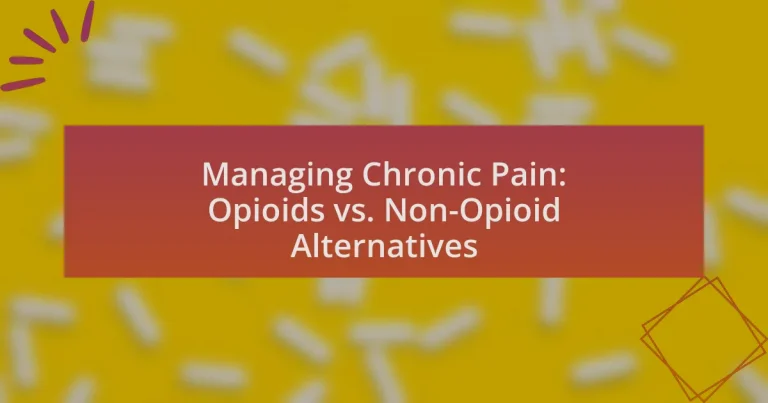Chronic pain management encompasses a multifaceted approach aimed at alleviating persistent pain lasting over three months, integrating medical treatments, physical therapies, psychological support, and lifestyle changes. The article examines the role of opioids in this context, detailing their effectiveness for severe pain, associated risks, and the importance of careful monitoring due to potential addiction. It also explores various non-opioid alternatives, including NSAIDs, antidepressants, and innovative therapies, emphasizing their efficacy and safety. Additionally, the article highlights the significance of patient preferences and healthcare provider guidelines in selecting appropriate pain management strategies, alongside recent advancements in non-opioid treatments and technologies that enhance patient care.
What is Chronic Pain Management?
Chronic pain management refers to the comprehensive approach used to alleviate persistent pain that lasts for an extended period, typically longer than three months. This management involves a combination of medical treatments, physical therapies, psychological support, and lifestyle modifications tailored to the individual’s needs. Evidence shows that effective chronic pain management can improve quality of life and functionality, as highlighted in studies indicating that multidisciplinary approaches often yield better outcomes than single-modality treatments.
How do opioids fit into chronic pain management?
Opioids are utilized in chronic pain management primarily for their analgesic properties, providing significant relief for patients with severe pain that does not respond to other treatments. They work by binding to specific receptors in the brain and spinal cord, effectively altering the perception of pain. Clinical guidelines, such as those from the Centers for Disease Control and Prevention (CDC), recommend opioids for chronic pain only when other non-opioid therapies are insufficient, emphasizing their role as a last resort due to risks of addiction and side effects. Studies indicate that while opioids can improve pain control and quality of life for some patients, their long-term use requires careful monitoring and consideration of alternative therapies to mitigate potential risks.
What are the different types of opioids used for pain relief?
The different types of opioids used for pain relief include natural opioids, semi-synthetic opioids, and synthetic opioids. Natural opioids, such as morphine and codeine, are derived from the opium poppy. Semi-synthetic opioids, like oxycodone and hydrocodone, are chemically modified versions of natural opioids. Synthetic opioids, including fentanyl and methadone, are entirely man-made and designed to mimic the effects of natural opioids. These classifications are based on their chemical structure and origin, which influence their potency and application in pain management.
How do opioids work in the body to alleviate pain?
Opioids alleviate pain by binding to specific receptors in the brain, spinal cord, and other areas of the body, which reduces the perception of pain. These receptors, known as opioid receptors, include mu, delta, and kappa types, and their activation leads to decreased transmission of pain signals and an increased pain threshold. Research indicates that opioids not only block pain signals but also trigger the release of neurotransmitters that promote feelings of euphoria, further contributing to their analgesic effects. This mechanism is supported by studies showing that opioid administration can significantly reduce pain levels in various clinical settings.
What are non-opioid alternatives for managing chronic pain?
Non-opioid alternatives for managing chronic pain include nonsteroidal anti-inflammatory drugs (NSAIDs), acetaminophen, antidepressants, anticonvulsants, physical therapy, acupuncture, and cognitive behavioral therapy. These alternatives provide effective pain relief without the risks associated with opioid use. For instance, NSAIDs like ibuprofen and naproxen reduce inflammation and pain, while antidepressants such as amitriptyline can help manage neuropathic pain. Research indicates that physical therapy can improve function and reduce pain in chronic conditions, and acupuncture has been shown to provide pain relief in various studies.
What types of non-opioid medications are available?
Non-opioid medications available for managing pain include nonsteroidal anti-inflammatory drugs (NSAIDs), acetaminophen, antidepressants, anticonvulsants, and topical analgesics. NSAIDs, such as ibuprofen and naproxen, reduce inflammation and alleviate pain. Acetaminophen is effective for mild to moderate pain relief. Antidepressants, particularly tricyclics like amitriptyline, can help manage chronic pain conditions. Anticonvulsants, such as gabapentin and pregabalin, are used for neuropathic pain. Topical analgesics, including lidocaine patches and capsaicin cream, provide localized pain relief. These medications are widely recognized in clinical guidelines for their efficacy in pain management without the risks associated with opioids.
How do non-opioid alternatives compare to opioids in effectiveness?
Non-opioid alternatives generally demonstrate lower effectiveness in managing severe pain compared to opioids. While opioids are highly effective for acute and severe pain relief, non-opioid alternatives, such as NSAIDs and acetaminophen, are often more suitable for mild to moderate pain and may not provide sufficient relief for more intense pain conditions. Research indicates that opioids can reduce pain by approximately 30-50% in severe cases, while non-opioid medications typically achieve a lower percentage of pain reduction, often around 20-30%. This difference highlights the need for careful consideration when choosing pain management strategies, particularly in cases of severe pain.
What are the risks associated with opioid use?
The risks associated with opioid use include addiction, overdose, and various side effects such as respiratory depression and constipation. Addiction occurs because opioids can create a physical dependence, leading to compulsive use despite harmful consequences. Overdose is a significant risk, with the Centers for Disease Control and Prevention reporting that nearly 70% of drug overdose deaths in 2019 involved opioids. Additionally, side effects can severely impact quality of life, with respiratory depression being particularly dangerous as it can lead to death if not managed properly.
What are the potential side effects of opioids?
Opioids can cause a range of potential side effects, including constipation, nausea, drowsiness, confusion, respiratory depression, and addiction. These side effects occur due to the way opioids interact with the brain and body, particularly their effect on the central nervous system. For instance, respiratory depression can be life-threatening, as opioids can slow down breathing to dangerous levels. According to the Centers for Disease Control and Prevention, overdose deaths involving opioids have significantly increased, highlighting the risks associated with their use.
How can opioid dependence or addiction develop?
Opioid dependence or addiction can develop through prolonged use of opioid medications, which leads to changes in brain chemistry and increased tolerance. When individuals use opioids for pain management, their bodies may adapt to the presence of the drug, requiring higher doses to achieve the same effect. This escalation can result in physical dependence, where withdrawal symptoms occur if the medication is reduced or stopped. Additionally, psychological factors, such as the relief of pain or emotional distress, can reinforce continued use, further contributing to the cycle of addiction. Research indicates that approximately 21-29% of patients prescribed opioids for chronic pain misuse them, highlighting the risk of developing dependence.
How do healthcare providers decide between opioids and non-opioid alternatives?
Healthcare providers decide between opioids and non-opioid alternatives based on a comprehensive assessment of the patient’s condition, pain severity, and potential risks associated with opioid use. They evaluate the effectiveness of non-opioid treatments, such as physical therapy or non-steroidal anti-inflammatory drugs, and consider the patient’s medical history, including any history of substance use disorder. Evidence from clinical guidelines, such as those from the Centers for Disease Control and Prevention, supports the preference for non-opioid therapies as first-line treatments for chronic pain, emphasizing the importance of minimizing opioid prescriptions to reduce the risk of addiction and adverse effects.
What factors influence the choice of pain management strategy?
The choice of pain management strategy is influenced by factors such as the type and severity of pain, patient medical history, potential side effects, and the effectiveness of available treatments. For instance, acute pain may require different management than chronic pain, leading to a preference for opioids in severe cases, while non-opioid alternatives may be favored for chronic conditions due to lower risks of dependency. Additionally, individual patient characteristics, including age, comorbidities, and personal preferences, play a crucial role in determining the most appropriate strategy. Evidence from clinical guidelines emphasizes the importance of a multidisciplinary approach, integrating both pharmacological and non-pharmacological methods tailored to the patient’s specific needs and circumstances.
How does the severity of pain affect treatment decisions?
The severity of pain significantly influences treatment decisions by guiding healthcare providers in selecting appropriate interventions. For instance, patients experiencing severe pain may be prescribed opioids due to their potent analgesic effects, as evidenced by studies indicating that opioids are often recommended for moderate to severe pain management. Conversely, for mild to moderate pain, non-opioid alternatives such as NSAIDs or physical therapy may be prioritized, reflecting clinical guidelines that advocate for a stepwise approach to pain management. This tailored decision-making process ensures that treatment aligns with the patient’s pain level, optimizing outcomes and minimizing the risk of adverse effects associated with stronger medications.
What role do patient preferences play in choosing pain management options?
Patient preferences significantly influence the selection of pain management options, as they determine the acceptability and adherence to treatment plans. Research indicates that when patients are involved in decision-making, they are more likely to choose options that align with their values, lifestyle, and concerns about side effects. For instance, a study published in the Journal of Pain Research found that patients who preferred non-opioid alternatives often cited fears of addiction and side effects associated with opioids as key factors in their decision-making process. This highlights the importance of considering individual patient preferences to enhance treatment outcomes and satisfaction in managing chronic pain.
What guidelines exist for prescribing opioids?
Guidelines for prescribing opioids include the CDC’s 2016 Guideline for Prescribing Opioids for Chronic Pain, which recommends non-opioid therapies as the first-line treatment for chronic pain. The guidelines emphasize the importance of assessing the patient’s risk for opioid misuse, starting with the lowest effective dose, and regularly monitoring the patient’s response to treatment. Additionally, they advise clinicians to consider the benefits and risks of continued opioid therapy, including the potential for addiction and overdose. These recommendations are based on evidence indicating that non-opioid treatments often provide effective pain relief with a lower risk of adverse outcomes.
What are the recommended dosages and duration for opioid prescriptions?
The recommended dosages for opioid prescriptions vary based on the specific opioid and the patient’s condition, but generally, for acute pain, initial doses may range from 5 to 15 mg of immediate-release morphine every 4 to 6 hours as needed. For chronic pain management, dosages often start lower and are titrated based on patient response, with a common range being 30 to 90 mg of morphine equivalent per day. The duration of opioid therapy should be as short as possible, typically not exceeding 3 to 7 days for acute pain, while chronic pain management may require longer durations but should be regularly reassessed to evaluate the necessity and effectiveness of continued use. These guidelines are supported by the Centers for Disease Control and Prevention (CDC) recommendations, which emphasize careful monitoring and adjustment of dosages to minimize risks associated with opioid use.
How can healthcare providers monitor patients on opioids effectively?
Healthcare providers can monitor patients on opioids effectively by implementing regular assessments, utilizing prescription drug monitoring programs (PDMPs), and conducting urine drug screenings. Regular assessments involve evaluating pain levels, functionality, and potential side effects during scheduled visits, which allows for timely adjustments to treatment plans. PDMPs provide healthcare providers with access to patients’ prescription histories, helping to identify patterns of misuse or over-prescribing. Urine drug screenings serve as a tool to confirm adherence to prescribed medications and detect the presence of illicit substances. These methods collectively enhance patient safety and ensure responsible opioid prescribing practices.
What are the latest developments in chronic pain management?
Recent developments in chronic pain management include the increased use of non-opioid alternatives, such as cannabinoids, nerve blocks, and neuromodulation techniques. Research has shown that cannabinoids can effectively reduce pain in certain conditions, while nerve blocks provide targeted relief by interrupting pain signals. Neuromodulation techniques, including spinal cord stimulation, have also gained traction, demonstrating efficacy in managing chronic pain without the risks associated with opioid use. These advancements reflect a growing emphasis on multimodal approaches that prioritize patient safety and minimize reliance on opioids.
How is research advancing non-opioid pain management options?
Research is advancing non-opioid pain management options through the development of innovative therapies and the exploration of alternative modalities. Recent studies have identified effective non-opioid medications, such as nonsteroidal anti-inflammatory drugs (NSAIDs) and anticonvulsants, which have shown promise in managing chronic pain conditions. For instance, a systematic review published in the Journal of Pain Research in 2021 highlighted the efficacy of gabapentinoids in neuropathic pain management, demonstrating significant pain reduction compared to placebo. Additionally, research into non-pharmacological approaches, such as cognitive-behavioral therapy and physical therapy, has provided evidence supporting their effectiveness in pain relief and improving patient outcomes. These advancements reflect a growing emphasis on multidisciplinary approaches to pain management, aiming to reduce reliance on opioids while enhancing overall patient care.
What innovative therapies are being explored for chronic pain relief?
Innovative therapies being explored for chronic pain relief include neuromodulation techniques, such as spinal cord stimulation and transcranial magnetic stimulation, as well as regenerative medicine approaches like platelet-rich plasma therapy and stem cell therapy. Neuromodulation techniques have shown efficacy in altering pain pathways, providing relief for patients who do not respond to traditional treatments. For instance, spinal cord stimulation has been reported to reduce pain levels by up to 70% in some patients, according to a study published in the journal Pain Medicine. Regenerative medicine approaches, particularly platelet-rich plasma therapy, have demonstrated potential in promoting tissue healing and reducing inflammation, with studies indicating significant pain reduction in conditions like osteoarthritis. These therapies represent a shift towards more personalized and less invasive options for managing chronic pain.
How do emerging technologies impact pain management strategies?
Emerging technologies significantly enhance pain management strategies by introducing innovative methods for assessment, treatment, and monitoring. For instance, telemedicine allows for remote consultations, enabling healthcare providers to evaluate and adjust pain management plans without requiring in-person visits. Additionally, wearable devices equipped with sensors can track physiological responses to pain and treatment, providing real-time data that informs personalized care. Research published in the Journal of Pain Research indicates that digital health interventions, such as mobile apps for pain tracking, improve patient engagement and adherence to treatment protocols. These advancements collectively lead to more effective, tailored pain management approaches, reducing reliance on opioids and improving patient outcomes.
What best practices should patients follow when managing chronic pain?
Patients managing chronic pain should follow a comprehensive approach that includes medication management, physical therapy, psychological support, and lifestyle modifications. Medication management involves working closely with healthcare providers to find the most effective pain relief options, which may include both opioid and non-opioid alternatives, tailored to individual needs. Physical therapy can enhance mobility and strength, while psychological support, such as cognitive-behavioral therapy, can help address the emotional aspects of chronic pain. Additionally, lifestyle modifications, including regular exercise, a balanced diet, and stress management techniques, can significantly improve overall well-being and pain management. Research indicates that a multidisciplinary approach is often more effective than relying solely on medication, as it addresses the complex nature of chronic pain (Gatchel et al., 2007, “The Biopsychosocial Approach to Chronic Pain: Theory and Practice,” Pain Physician).
How can patients effectively communicate with their healthcare providers about pain management?
Patients can effectively communicate with their healthcare providers about pain management by clearly articulating their pain levels, describing the nature of their pain, and discussing the impact of pain on their daily lives. This involves using a pain scale to quantify pain intensity, providing specific examples of pain triggers, and expressing any concerns regarding current treatment options. Research indicates that effective communication can lead to better pain management outcomes, as studies show that patients who actively engage in discussions about their pain report higher satisfaction with their care and improved pain relief.
What lifestyle changes can support chronic pain management efforts?
Lifestyle changes that can support chronic pain management efforts include regular physical activity, maintaining a healthy diet, practicing stress management techniques, ensuring adequate sleep, and engaging in social support networks. Regular physical activity, such as low-impact exercises, has been shown to improve mobility and reduce pain levels, as evidenced by a study published in the Journal of Pain Research, which found that exercise can lead to significant reductions in chronic pain symptoms. A healthy diet rich in anti-inflammatory foods can also contribute to pain relief; for instance, omega-3 fatty acids found in fish have been linked to reduced inflammation. Stress management techniques, such as mindfulness and meditation, can lower pain perception, supported by research from the American Psychological Association indicating that stress exacerbates chronic pain. Adequate sleep is crucial, as sleep deprivation can worsen pain sensitivity, according to findings from the Sleep Research Society. Lastly, social support has been associated with better pain outcomes, as individuals with strong social networks report lower levels of pain and improved coping strategies.





